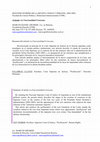Papers by Marcos Grubisic

Temas y Debates, Mar 18, 2006
Reconociendo la posición de la Corte Suprema de Justicia de la Nación argentina como neurálgica e... more Reconociendo la posición de la Corte Suprema de Justicia de la Nación argentina como neurálgica en el sistema político institucional, este artículo describe el estado de creación de vacantes en la Corte Suprema, en el contexto de los dos primeros años de la administración del presidente Néstor Kirchner (2003-2005), y la designación de los ministros que reemplazaron a los principales referentes de la “mayoría automática menemista”.
Este artículo también analiza el funcionamiento de la nueva composición de la Corte, una aproximación a los principales fallos sobre las dos cuestiones de mayor trascendencia: la “pesificación” y la declaración de inconstitucionalidad de las leyes de impunidad sobre crímenes de lesa humanidad en la última dictadura militar.
By situating the Nacional Supreme Court of Justice of Argentina as axis of the institutional political system, the present article describes the stages in the creation of vacancies in the Supreme Court, in the context of the first two years of Mr President Néstor Kirchner’s administration (2003-2005); and the appointment of the new ministers who replaced the main referents of the “menemist automatic majority”.
This article also analyses the performance of the new formation of the Court, mainly the veredicts related to the two most important issues which were approached: “pesificación” and declaration inconstitutionality of the impunity laws over crimes “lesa humanidad” in the last military dictatorship.
El objetivo central de esta tesis es determinar el rol político-institucional y la preponderancia... more El objetivo central de esta tesis es determinar el rol político-institucional y la preponderancia de la Corte Suprema de Justicia nacional en la configuración de la legislación y las regulaciones vigentes. Es precisar la dirección normativa del régimen social de acumulación y de los regímenes políticos para preservar y/o alterar una continuidad preceptiva de carácter superior que de manera directa e indirecta modelan un Estado, una sociedad y un individuo. Además, responde de manera neurálgica a la pregunta de cuál fue la actuación política, institucional y jurídica/jurisprudencial de la Corte Suprema federal en la recreación de las pautas formales de actuación de los distintos actores del sistema político argentino entre 1930 y 1947.Fil: Grubisic, Marcos Daniel. Universidad Nacional de Rosario. Facultad de Ciencia Política y Relaciones Internacionales; Argentin
La funcionalidad cortesana











Uploads
Papers by Marcos Grubisic
Este artículo también analiza el funcionamiento de la nueva composición de la Corte, una aproximación a los principales fallos sobre las dos cuestiones de mayor trascendencia: la “pesificación” y la declaración de inconstitucionalidad de las leyes de impunidad sobre crímenes de lesa humanidad en la última dictadura militar.
By situating the Nacional Supreme Court of Justice of Argentina as axis of the institutional political system, the present article describes the stages in the creation of vacancies in the Supreme Court, in the context of the first two years of Mr President Néstor Kirchner’s administration (2003-2005); and the appointment of the new ministers who replaced the main referents of the “menemist automatic majority”.
This article also analyses the performance of the new formation of the Court, mainly the veredicts related to the two most important issues which were approached: “pesificación” and declaration inconstitutionality of the impunity laws over crimes “lesa humanidad” in the last military dictatorship.
Este artículo también analiza el funcionamiento de la nueva composición de la Corte, una aproximación a los principales fallos sobre las dos cuestiones de mayor trascendencia: la “pesificación” y la declaración de inconstitucionalidad de las leyes de impunidad sobre crímenes de lesa humanidad en la última dictadura militar.
By situating the Nacional Supreme Court of Justice of Argentina as axis of the institutional political system, the present article describes the stages in the creation of vacancies in the Supreme Court, in the context of the first two years of Mr President Néstor Kirchner’s administration (2003-2005); and the appointment of the new ministers who replaced the main referents of the “menemist automatic majority”.
This article also analyses the performance of the new formation of the Court, mainly the veredicts related to the two most important issues which were approached: “pesificación” and declaration inconstitutionality of the impunity laws over crimes “lesa humanidad” in the last military dictatorship.